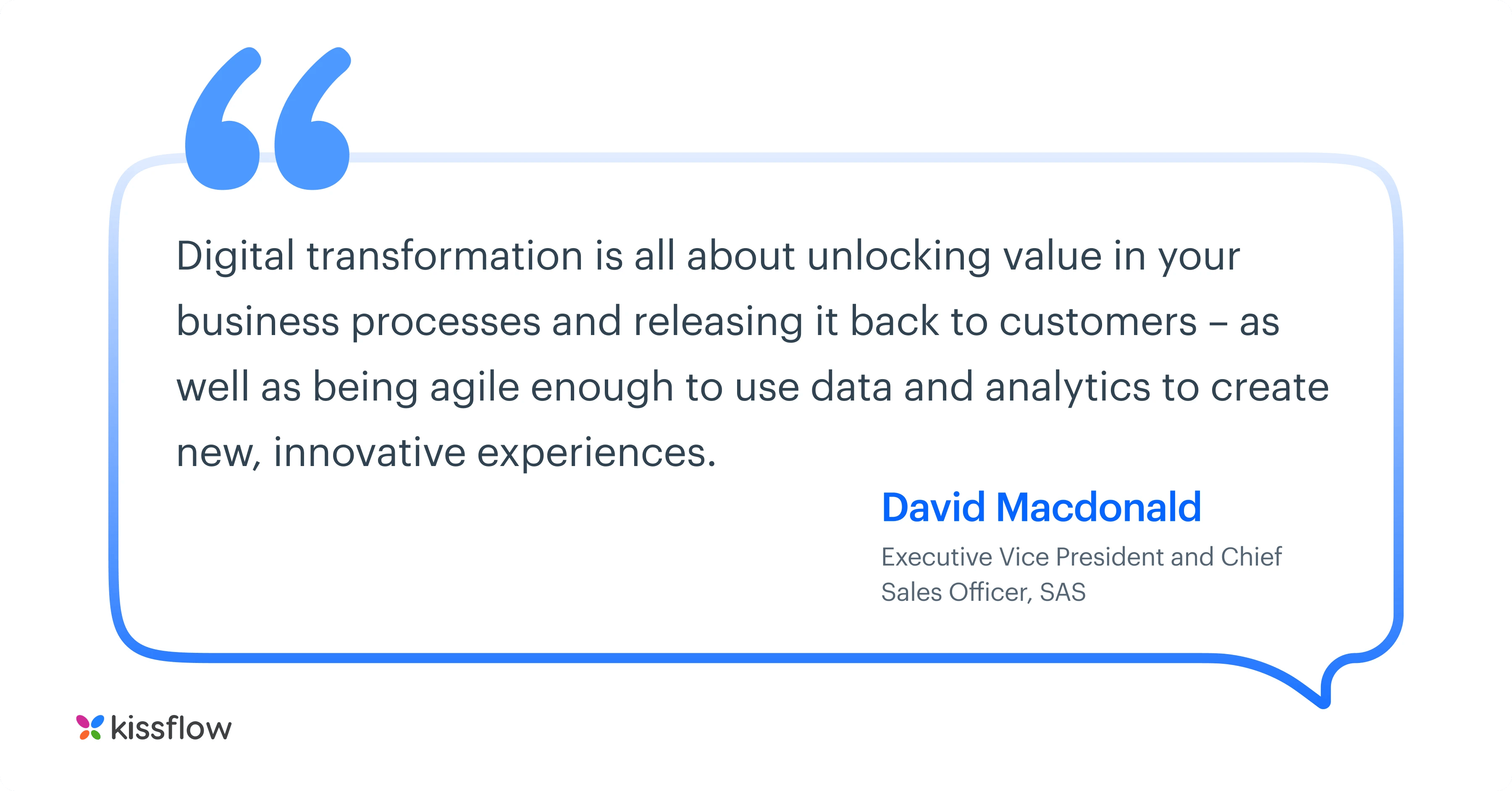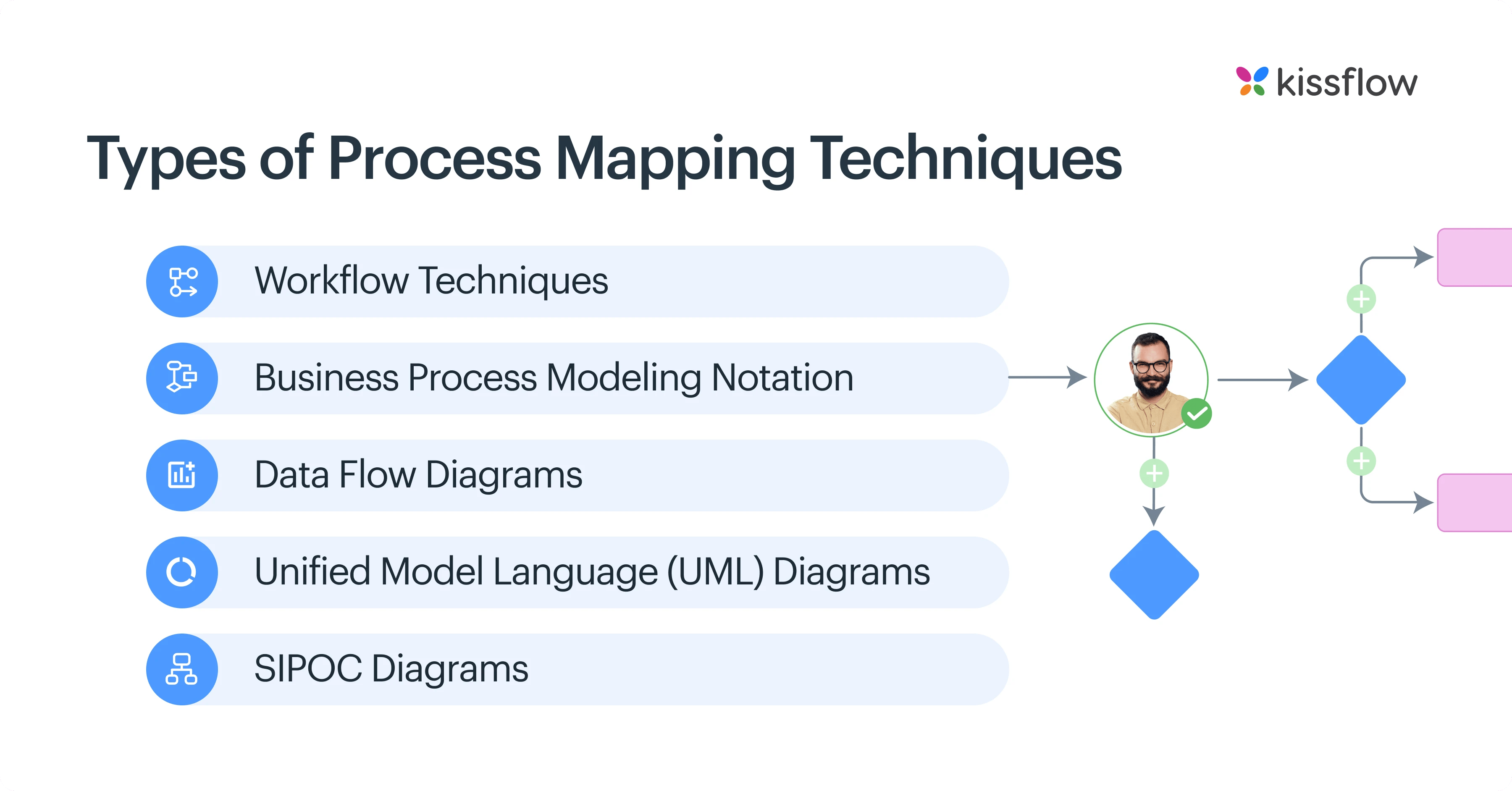Related Articles

Team Kissflow
Updated on 20 Jun 2025 • 4 min read
Business process mapping provides a visual roadmap for existing processes in an enterprise, allowing CIOs to identify inefficiencies, bottlenecks, and opportunities for automation effectively.
By implementing the right business process mapping techniques that align with the organization's goals and digital transformation initiatives, it's possible to improve process flow and increase transparency in decision-making.
Let’s look at the different process mapping techniques that can significantly improve process efficiency.
Business process mapping, as a subset of BPM, is a powerful way to visually depict processes. It allows you to see how a process functions from start to finish, one step after another.
BPM focuses on analyzing, optimizing, and automating processes to enhance efficiency and effectiveness. By mapping processes, companies can create a clear, structured approach to process improvement, ensuring alignment with organizational goals.
Business process mapping answers the following questions using charts, flowcharts, and symbols:

Business process mapping is critical to boosting efficiency in an organization. Without clarity in processes, chaos, redundancies, delays, and a complete lack of accountability take over operations. A reliable BPM tool can help map, visualize, and streamline these processes—because nothing can drive a business to the ground faster than messy and vague workflows
Utilizing business process mapping can help your company in the following ways:

Thanks for submitting the form.

There are many types of process mapping techniques and methods. A long list might include: Gantt charts, UML diagrams, business process modeling notation, flowcharts, data flow diagrams, role activity diagrams, integrated definition for function modeling, Petri nets, object oriented methods, workflow technique, and simulation models, all with their own unique strength.
Some of the popular process mapping techniques include:
Workflows comprise of sequences of tasks between people in an organization or between computer applications. They involve more than just modeling processes. They also help analyze and improve the processes. The various stages in a workflow include gathering information, business process modeling, workflow modeling, implementation, verification, and execution.
BPMN is a technique that is preferred by process experts. It is a standardized language that is ideal for situations when you need to drill down into processes to fix errors and exceptions. While it is very popular, if you’re not a business analyst, trying to utilize this technique could be counterproductive.
Also known as Yourdon’s technique, data flow diagrams show you how information flows from one place to another. They represent how the process links through data stores and how it relates to the external environment.
UML diagrams are best suited for mapping out software building. There are two categories within UML – behavioral and structural diagrams. UML is seen as a specialized mapping tool for specific industries, so it isn’t suited for creating process workflows.
SIPOC diagrams are also called high-level process maps. They visually represent a process without going into too much detail. A SIPOC diagram breaks the process down into the following sections – suppliers, input, process, output, and customers.
Assuming that improved business efficiency is your goal, the right process mapping software should be
Business process mapping doesn’t need to be complex or require experts to be effective. After all, simplicity is the ultimate sophistication, as Leonardo da Vinci said.
⋙ Click here and find out why these 5 Process Mapping Tools are at the top of the competition!
Kissflow is a powerful low-code platform that allows you to streamline business processes across the organization. With its intuitive visual approach and drag-and-drop editor, you can visually map processes and build them from scratch.
Kissflow also offers a wide range of reporting and analytics features that give an accurate snapshot of the performance of different business processes, allowing you to identify and fix inefficiencies quickly.
Solve your workflow challenges with Kissflow and optimize your team's productivity.
1. What are the different methods of process mapping?
Process mapping methods include flowcharts (sequential visualization of steps and decisions), swimlane diagrams (clarifying role responsibilities across departments), value stream maps (highlighting waste and delays), BPMN diagrams (using standardized notation for technical implementation), SIPOC diagrams (high-level overview of suppliers, inputs, process, outputs, and customers), and hierarchical process maps showing relationships between processes at different levels.
2. How do businesses use process mapping for efficiency?
Businesses use process mapping for efficiency by visualizing current workflows to identify redundancies and bottlenecks, creating standardization opportunities across departments or locations, documenting tribal knowledge to reduce dependency on specific employees, establishing baselines for measuring improvement efforts, facilitating employee training, and creating a shared understanding of how work flows through the organization.
3. What tools help with process mapping?
Tools that help with process mapping include visual diagramming software with process-specific templates, collaborative whiteboarding platforms for team input, process mining tools that automatically discover actual workflows from system logs, simulation software for testing improvement scenarios, mobile apps for capturing processes on-site, and integration capabilities with process execution platforms for implementation.
4. What industries benefit the most from process mapping?
Industries benefiting most from process mapping include manufacturing (optimizing production workflows), healthcare (improving patient journeys), financial services (streamlining complex compliance processes), government agencies (reducing bureaucracy), logistics (optimizing supply chains), and professional services (standardizing service delivery). Any organization with complex, cross-functional processes gains significant value.
5. What are common process mapping mistakes to avoid?
Common process mapping mistakes to avoid include mapping ideal processes rather than current reality, creating overly detailed maps that become unwieldy, failing to involve the people who actually do the work, ignoring exception handling for non-standard cases, using inconsistent notation that confuses participants, focusing solely on activities rather than outputs and value, and creating maps without clear purpose or follow-up actions.
Related Articles
Welcome.
Let's get started.
To begin, tell us a bit about yourself
By proceeding, you agree to our Terms of Service and Privacy Policy
"The beauty of Kissflow is how quick and easy it is to create the apps I need. It's so user-friendly that I made exactly what I needed in 30 minutes."
Oliver Umehara
IT Manager - SoftBank
A Trusted Choice for Companies Globally




Thank you for signing up
Someone from our team will contact you soon.

Know why all the IT leaders converging at booth #602
Earn a chance to be part of our experience event

Get the first look at the 2024 Citizen Development report
Welcome.
Let's get started.
By proceeding, you agree to our Terms of Service and Privacy Policy
Wondering where to start?
Let's talk!
Connect with our solution experts to gain insights on how Kissflow can help you transform ideas into reality and accelerate digital transformation

%20(1)%20(1).png?width=1997&height=1800&name=The%20ultimate%20buyers%20guide%20to%20BPM%20(1)%20(1)%20(1).png)
Wait! Don’t leave without your free BPM guide, it’s gold!
This website uses cookies to ensure you get the best experience. Check our Privacy Policy


